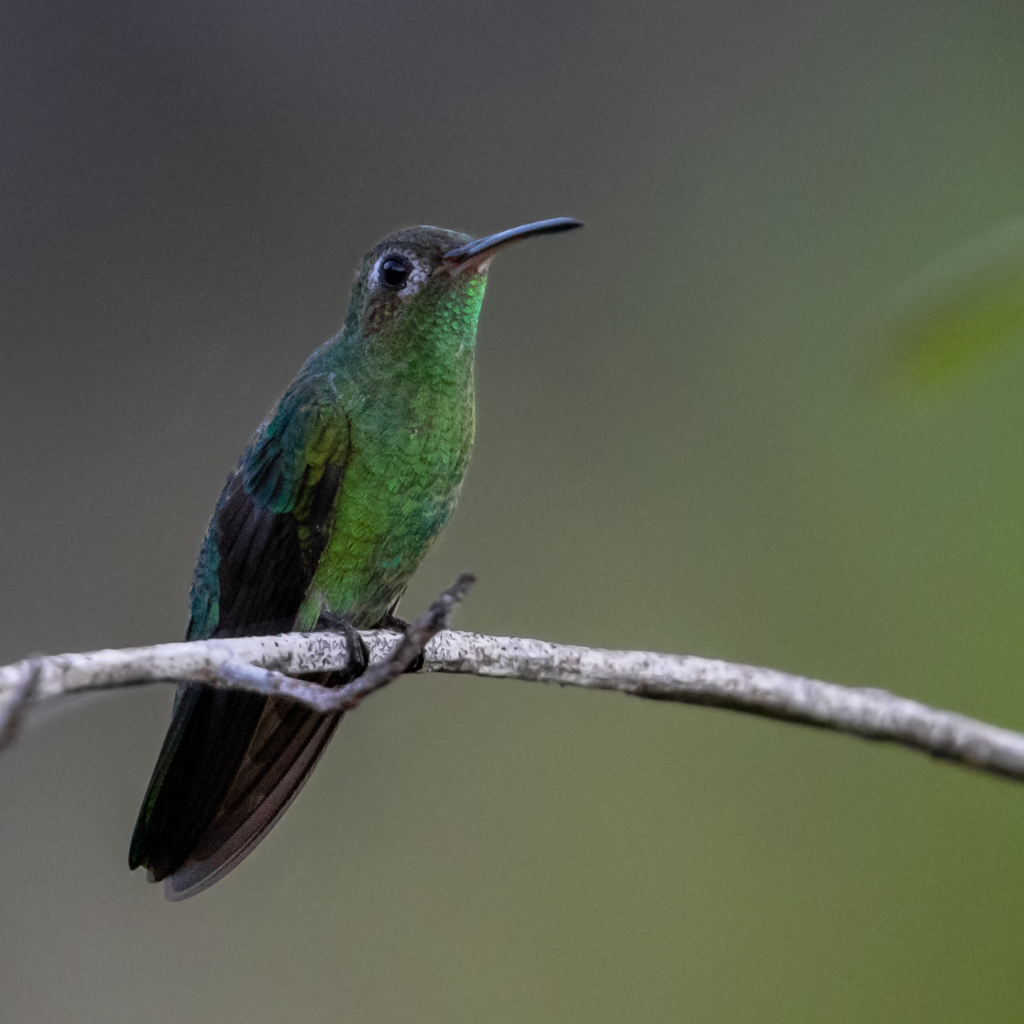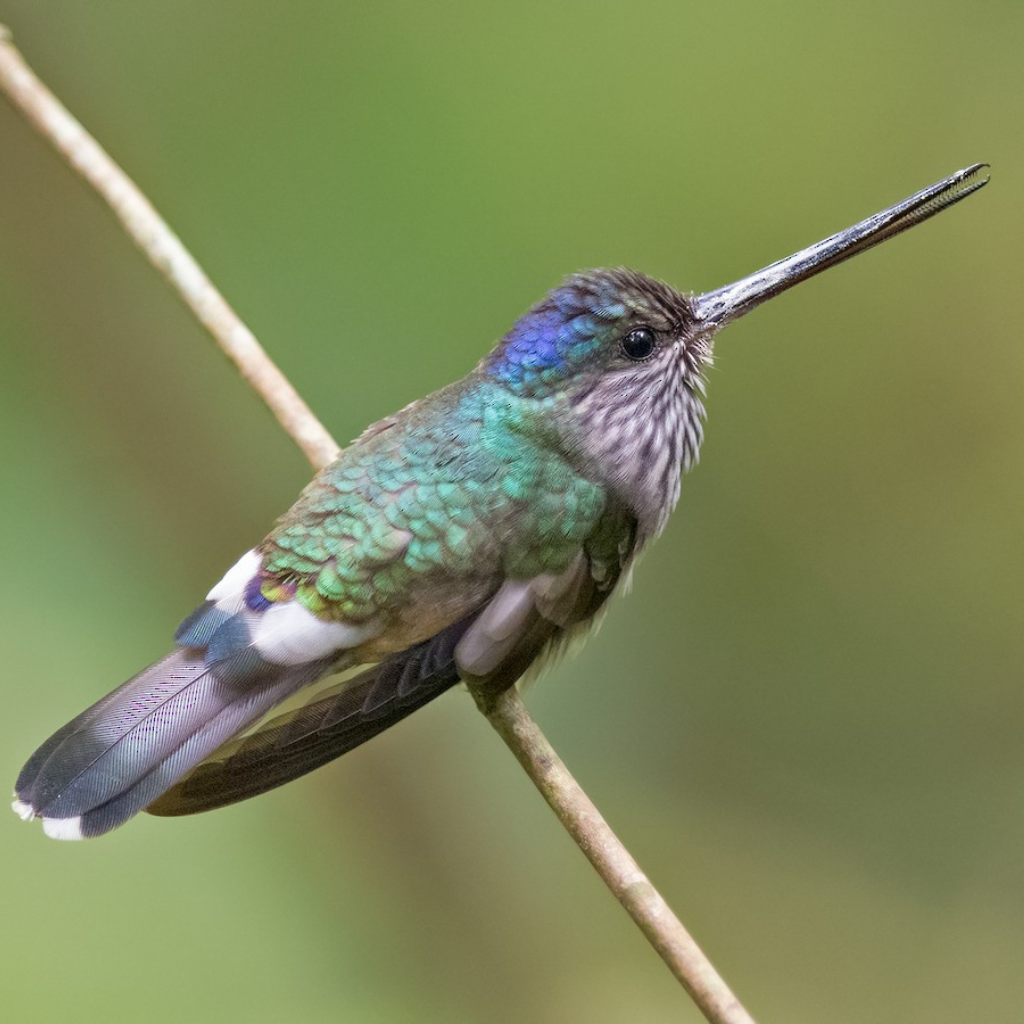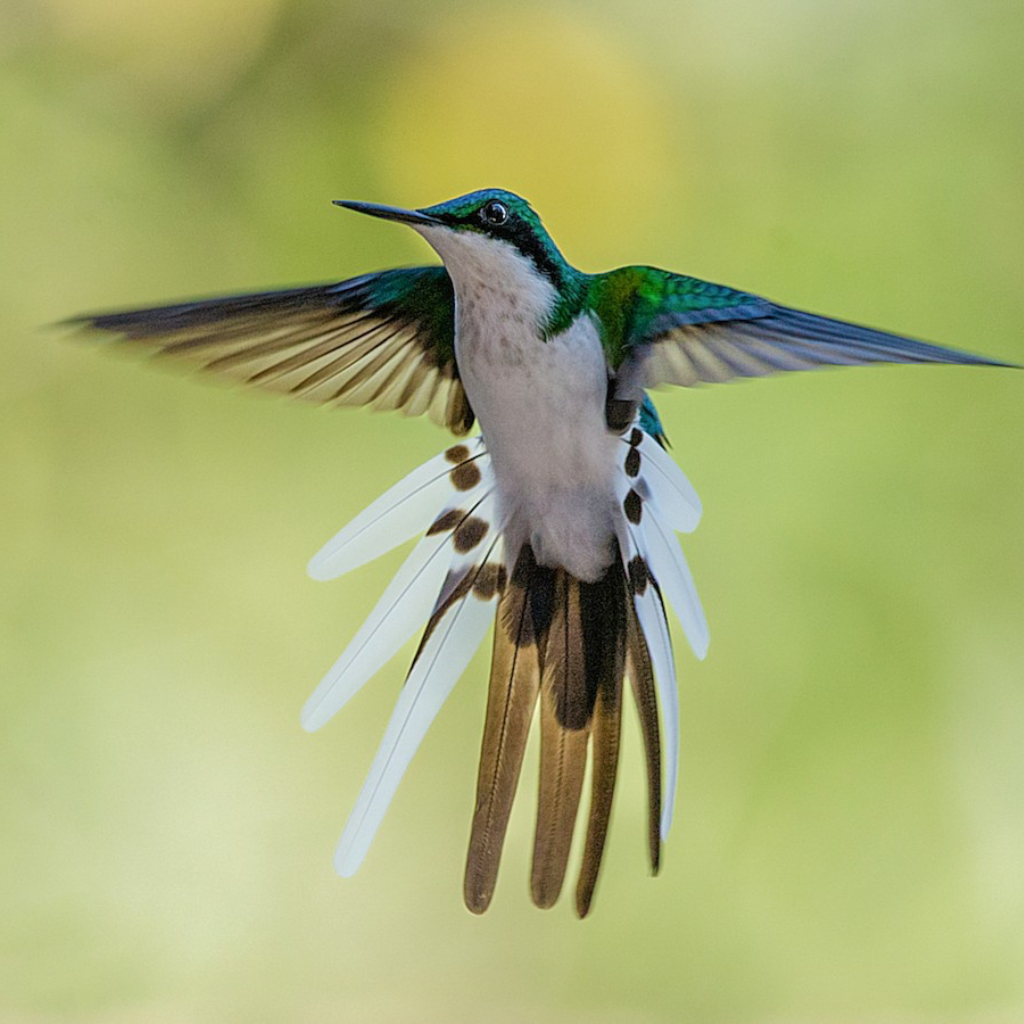Hummingbird
More about Hummingbird
The hummingbird represents the very best of what life has to offer: beauty, energy, and resilience. As one of the smallest birds in the world, the hummingbird is often overlooked, but its vibrant colors and extraordinary abilities make it an unforgettable creature.

Green-tailed Goldenthroat
The Green-tailed Goldenthroat is a striking and fascinating hummingbird species, known for its brilliant green tail feathers, golden-yellow throat patch, and aggressive territorial behaviour.
The Green-tailed Goldenthroat (Chlorestes eliciae) is a stunning hummingbird species native to Central and South America. As the name suggests, this hummingbird is characterized by its brilliant emerald-green tail feathers and golden-yellow throat patch.
Males of this species have a metallic green head, back, and upperparts, with a golden-yellow throat and breast. Their underparts are white, and their tail feathers are a vibrant emerald green. Females are similar in appearance, but they have a more subdued color palette, with a duller green head and upperparts, and a less distinct golden-yellow throat patch.
Juvenile Green-tailed Goldenthroats resemble the females, but they have a more buff-colored breast and belly. As they mature, their colors become more vibrant and distinct.
This hummingbird species is relatively small, with a length of approximately 3.5-4 inches (9-10 cm) and a wingspan of around 5 inches (13 cm). They have a slender, needle-like bill, which is adapted for probing deep into flowers to access nectar.
The Green-tailed Goldenthroat is known for its aggressive behavior, particularly during breeding season. Males establish territories and fiercely defend them from other hummingbirds, using their brilliant plumage and aerial acrobatics to ward off intruders.
Overall, the Green-tailed Goldenthroat is a striking and fascinating hummingbird species, known for its brilliant green tail feathers, golden-yellow throat patch, and aggressive territorial behavior.
Tooth-billed Hummingbird
Tooth-billed Hummingbird is a striking and fascinating hummingbird species, known for its unique tooth-like bill, brilliant green plumage, and aggressive territorial behaviour.
The Tooth-billed Hummingbird (Androdon aequinoctialis) is a distinctive and striking hummingbird species native to Central and South America. As the name suggests, this hummingbird is characterized by its uniquely tooth-like bill, which sets it apart from other species in the family.
Males of the Tooth-billed Hummingbird are primarily green in color, with a metallic bronze sheen on their backs and heads. They have a white throat and underparts, with a dark, curved beak that resembles a tooth. Females are similar in appearance, but they have a less pronounced tooth-like bill and may have a duller green coloration.
Juvenile Tooth-billed Hummingbirds resemble the females, but they have a more buff-colored breast and belly. As they mature, their colors become more vibrant and distinct.
This hummingbird species is relatively small, with a length of approximately 3.5-4 inches (9-10 cm) and a wingspan of around 5 inches (13 cm). They have a slender, needle-like bill, which is adapted for probing deep into flowers to access nectar.
The Tooth-billed Hummingbird is known for its aggressive behavior, particularly during breeding season. Males establish territories and fiercely defend them from other hummingbirds, using their brilliant plumage and aerial acrobatics to ward off intruders.
Overall, the Tooth-billed Hummingbird is a striking and fascinating hummingbird species, known for its unique tooth-like bill, brilliant green plumage, and aggressive territorial behavior.


Ruby Topaz Hummingbird
The Ruby Topaz Hummingbird is a striking and fascinating hummingbird species, known for its brilliant ruby-red plumage, topaz-green throat patch, and aggressive territorial behavior
The Ruby Topaz Hummingbird (Chrysolampis mosquitus) is a stunning hummingbird species native to South America. As the name suggests, this hummingbird is characterized by its ruby-red plumage on the head, back, and upperparts, and a shimmering topaz-green throat and breast.
Males of this species have a metallic green head, back, and upperparts, with a brilliant ruby-red throat and breast. Their underparts are white, and their tail feathers are a vibrant emerald green. Females are similar in appearance, but they have a more subdued color palette, with a duller green head and upperparts, and a less distinct ruby-red throat patch.
Juvenile Ruby Topaz Hummingbirds resemble the females, but they have a more buff-colored breast and belly. As they mature, their colors become more vibrant and distinct.
This hummingbird species is relatively small, with a length of approximately 3.5-4 inches (9-10 cm) and a wingspan of around 5 inches (13 cm). They have a slender, needle-like bill, which is adapted for probing deep into flowers to access nectar.
The Ruby Topaz Hummingbird is known for its aggressive behavior, particularly during breeding season. Males establish territories and fiercely defend them from other hummingbirds, using their brilliant plumage and aerial acrobatics to ward off intruders.
Overall, the Ruby Topaz Hummingbird is a striking and fascinating hummingbird species, known for its brilliant ruby-red plumage, topaz-green throat patch, and aggressive territorial behavior.
Fiery-tailed Awlbill Hummingbird
Fiery-tailed Awlbill Hummingbird is a striking and fascinating hummingbird species, known for its fiery-orange tail feathers, metallic green head and upperparts, and aggressive territorial behavior.
The Fiery-tailed Awlbill Hummingbird (Eulampis holosericeus) is a stunning hummingbird species native to the Caribbean region. As the name suggests, this hummingbird is characterized by its fiery-orange tail feathers, which contrast beautifully with its metallic green head, back, and upperparts.
Males of this species have a glossy green crown, nape, and upperparts, with a coppery-bronze throat and breast. Their underparts are white, and their tail feathers are an intense orange-red, giving them a distinctive appearance among hummingbirds.
Females are similar in appearance but have a less vibrant coloration. Their throat and breast are more yellowish-green, and their tail feathers are less intense in color.
Juvenile Fiery-tailed Awlbill Hummingbirds resemble the females, but they have a more buff-colored breast and belly. As they mature, their colors become more vibrant and distinct.
This hummingbird species is relatively small, with a length of approximately 3.5-4 inches (9-10 cm) and a wingspan of around 5 inches (13 cm). They have a slender, needle-like bill, which is adapted for probing deep into flowers to access nectar.
The Fiery-tailed Awlbill Hummingbird is known for its aggressive behavior, particularly during breeding season. Males establish territories and fiercely defend them from other hummingbirds, using their brilliant plumage and aerial acrobatics to ward off intruders.
Overall, the Fiery-tailed Awlbill Hummingbird is a striking and fascinating hummingbird species, known for its fiery-orange tail feathers, metallic green head and upperparts, and aggressive territorial behavior.


Black-eared Fairy Hummingbird
Black-eared Fairy Hummingbird is a striking and fascinating hummingbird species, known for its black ear patches, brilliant green and blue plumage, and aggressive territorial behavior.
The Black-eared Fairy (Basilinna xantusii) is a stunning hummingbird species native to western Mexico. As the name suggests, this hummingbird is characterized by its black ear patches, which contrast beautifully with its metallic green and blue plumage.
Males of this species have a glossy green head, back, and upperparts, with a brilliant blue throat and breast. Their underparts are white, and they have a distinctive black ear patch on each side of their head. Females are similar in appearance, but they have a more subdued color palette, with a duller green head and upperparts and a less distinct blue throat patch.
Juvenile Black-eared Fairy Hummingbirds resemble the females, but they have a more buff-colored breast and belly. As they mature, their colors become more vibrant and distinct.
This hummingbird species is relatively small, with a length of approximately 3.5-4 inches (9-10 cm) and a wingspan of around 5 inches (13 cm). They have a slender, needle-like bill, which is adapted for probing deep into flowers to access nectar.
The Black-eared Fairy Hummingbird is known for its aggressive behavior, particularly during breeding season. Males establish territories and fiercely defend them from other hummingbirds, using their brilliant plumage and aerial acrobatics to ward off intruders.
Overall, the Black-eared Fairy Hummingbird is a striking and fascinating hummingbird species, known for its black ear patches, brilliant green and blue plumage, and aggressive territorial behavior.



